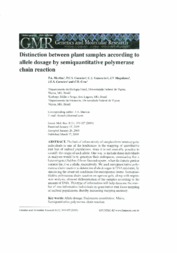Distinction between plant samples according to allele dosage by semiquantitative polymerase chain reaction.
Distinction between plant samples according to allele dosage by semiquantitative polymerase chain reaction.
Author(s): MARTINS, F. A.; CARNEIRO, P. C. S.; GUIMARAES, C. T.; MAGALHAES, J. V. D.; CARNEIRO, J. E. S.; CRUZ, C. D.
Summary: The lack of informativity of samples from heterozygotic individuals is one of the hindrances in the mapping of quantitative trait loci of outbred populations, since it is not normally possible to identify the origin of each allele. One way to include these individuals in analyses would be to genotype their endosperm, considering that heterozygote (Aa) has AAa endosperm, when the female genitor donates the A or a allele, respectivelly. We used semiquantitative polymerase chain reaction to determine allele dosages in DNA mixtures, by simulating the observed conditions for endospermic tissue. Semiquantitative polymerase chain reaction on agarose gels, along with regression analysis, allowed differentiation of the samples according to the amount of DNA. This type of information will help decrease the number of non-informative individuals in quantitative trait locus mapping of outbred populations, thereby increasing mapping accuracy.
Publication year: 2009
Types of publication: Journal article
Unit: Embrapa Maize & Sorghum
Keywords: Genética vegetal, Milho, Zea mays
Observation
Some of Embrapa's publications are published as ePub files. To read them, use or download one of the following free software options to your computer or mobile device. Android: Google Play Books; IOS: iBooks; Windows and Linux: Calibre.
Access other publications
Access the Agricultural Research Database (BDPA) to consult Embrapa's full library collection and records.
Visit Embrapa Bookstore to purchase books and other publications sold by Embrapa.

